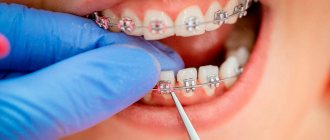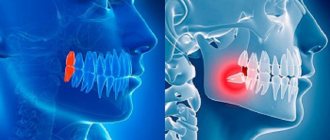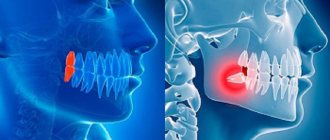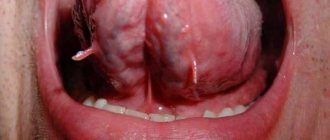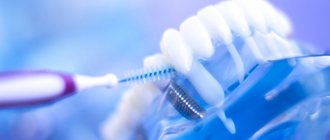Why does a tooth hurt under a crown?
Sometimes after prosthetics, not only the “living” tooth hurts, but also the “dead”, pulpless tooth in which the nerve was removed. This may be due to inflammation of the periodontal tissues, resulting from a variety of reasons. The specialists of the YuliStom clinic have more than once had to deal with mistakes made by dentists in some clinics when installing crowns. They examine the patient, find out why the tooth hurts under the crown and eliminate the identified pathology. The most common mistakes made by dentists and patients are described below.
Pulpitis, periodontitis, periostitis
Inflammation of the pulp (the soft tissue of the tooth cavity and root canals) is a consequence of its incomplete removal in the process of preparation for prosthetics. If the tooth cavity has been opened, the infection in the mouth gets into it, so in most cases, before prosthetics, the pulp is removed - depulpation. Poor performance of this procedure leads to the development of infection and the appearance of a focus of inflammation, accompanied by severe pain, since the pulp is penetrated by nerve endings. Inflammation can also begin when the root canals are incompletely filled: infection develops in the unfilled areas.
Inflammatory process in tooth tissues
If the process is not stopped, the inflammation will spread to the periodontium - the ligament that holds the tooth in the cell. The pain intensifies and becomes pulsating. With purulent inflammation, a fistula may appear - pus begins to make its way to the surface of the gum. When the infection progresses further, the jaw tissue is affected, first the periosteum (periostitis or flux), and then the bone (osteomyelitis). Inflammation of soft tissues leads to the development of abscesses and phlegmons.
Perforation of channel walls
Sometimes during the process of cleaning the root canals or when installing a pin into a preserved root, a perforation of the root canal occurs. The infection enters the canal and causes inflammation. Aching pain and bad breath appear. May be complicated by periodontitis.
Perforation of the canal walls
Foreign body in the root canal
When cleaning dental root canals, the tip of a dental instrument occasionally breaks off. It remains in the root canal, injures its walls and prevents complete filling. In this case, the tooth first hurts when biting, and then the inflammatory process occurs and periodontitis develops with severe throbbing pain.
Periodontitis
Periodontitis is an inflammation of the periodontal tissues. The installation of a crown is rarely the cause of its development. More often this is a consequence of ignoring contraindications to prosthetics. Before installing a crown, periodontitis is treated and prosthetics are performed in the absence of an inflammatory process.
Cysts, granulomas
Cyst on the root of a tooth
With long-term chronic periodontitis, against the background of improper filling of the root canals, a small nodule can form in the area of the root apex, enclosed in a thin capsule, inside which immature connective tissue cells—granulations—grow. This is a granuloma; it can be asymptomatic for a long time, gradually increasing in size and turning into a cyst - a formation covered with a dense capsule, filled inside with inflammatory fluid.
It is impossible to detect an independent cyst or granuloma. Most often, these formations can only be seen on an x-ray.
Inflammatory processes in the granuloma and cyst can periodically become inflamed due to hypothermia, stress and other external influences. This is accompanied by pain, swelling of the gums and increased body temperature, and in the absence of adequate treatment will lead to the development of even more severe complications.
Odontogenic sinusitis
Odontogenic sinusitis
Inflammation of the maxillary sinus due to dental pathology, including after installation of an artificial crown (odontogenic sinusitis) is a consequence of untreated caries of the upper jaw, complicated by periodontitis. Another cause of sinusitis may be a perforation of the wall of the maxillary sinus during the treatment of the teeth of the upper jaw and entry into the cavity of infection.
Root crack or fracture
Tooth root fracture
Aching pain when biting can occur when a tooth root is cracked or fractured. The root is injured when the instrument presses too hard on the walls of the root canals during cleaning or filling. A crack or fracture may not appear immediately, but after a significant load on the tooth. A root fragment during a fracture can injure the periodontal tissues, which is often accompanied by infection and the development of purulent-inflammatory processes.
Incorrect crown installation
If the installed crown does not adhere tightly to the natural dental tissues in the cervical area, then an infection gets under it, which leads to the development of secondary caries and inflammation of the periodontal tissues. This is a mistake made by the orthopedic dentist. Swelling causes compression of nerve endings and pain even with a pulpless tooth.
Large load on the tooth
This may be due to:
- incorrect size of the prosthesis if it is higher than adjacent units; this is a consequence of an incorrectly taken impression or a defect in the installation of the structure;
- the patient constantly chewing nuts, seeds and other hard foods.
Poor oral hygiene
With improper or irregular oral care, colonies of bacteria are deposited on natural and artificial crowns, the acidity of the oral cavity changes, which negatively affects the condition of the prosthesis and contributes to the development of inflammatory processes in the periodontal tissues, accompanied by toothache.
What can cause pain on the front teeth?
First of all, the fact that the front lower or upper teeth hurt, of course, is due to incorrect or insufficient oral hygiene. You can also identify such provoking factors as:
- constant mechanical impact, for example, due to a love of nuts or seeds;
- non-compliance with the dentist’s recommendations after treatment;
- bruxism (grinding teeth in sleep);
- untreated teeth in the mouth;
- hereditary predisposition;
- poor nutrition;
- occupational hazards (boxers, trumpet players, etc.);
- using forks, toothpicks, needles to clean interdental spaces;
- malocclusion.
It is important not to forget that the gap between the front teeth is often so narrow that it is impossible to get any leftover food out of it. This is why flossing your front teeth is important. It is also very important to visit the dentist on time, since carious stains are often located on the inner surface of the tooth, and only a doctor can see them.
If your front teeth hurt, most likely this means that pulpitis has begun to develop due to advanced caries.
First, the tooth begins to respond acutely to temperature fluctuations (hot drinks, cold weather, etc.), then it begins to bother you when biting food. At a later stage, sharp pain in the front teeth can occur at any time, even during sleep.
In this case, you need to contact your dentist, and the sooner the better. Only he can cure this disease and restore health and beauty to your smile.
What to do if a tooth hurts under a crown
Severe toothache sometimes appears at the wrong time: at work or at night. In this case, there is no way to immediately contact a dentist. What to do if a tooth hurts under a crown, how to remove it and is it possible to do this? You can relieve pain using medications with analgesic properties or folk remedies.
Remember that it is necessary to temporarily relieve pain, but this does not cancel a visit to the doctor. In addition, you need to remember the maximum daily dose of the drug taken - it is indicated in the instructions for it.
Medications
Medicines from the group of non-steroidal anti-inflammatory drugs (NSAIDs) are very helpful. If you do not have diseases of the gastrointestinal tract (especially ulcerative processes in the gastrointestinal tract), then you can use one of the following remedies:
- Ketorol – 1 tablet 10 mg;
- Diclofenac – 1 rectal suppository 100 mg;
- Nurofen – 1 tablet 200 mg.
These agents suppress the action of biologically active substances that cause inflammation and pain, and also protect the gastrointestinal mucosa from any influences. They will relieve pain, but will cause an exacerbation of the ulcerative process in the gastrointestinal tract. Therefore, for people suffering from gastric ulcers, it is better to take nimesulide (trade name Nise) - 1 tablet of 100 mg. Nise belongs to the latest generation of NSAIDs and does not have a negative effect on the gastrointestinal tract.
Folk remedies
What to do when a tooth hurts under a crown, but you don’t have the necessary tablets at hand? It is worth turning to people's experience. Sometimes folk remedies help as well as drug therapy. Take:
- a piece of salted (but not smoked!) lard and place it on the gum next to the sore spot; salted lard will draw out fluid, eliminate swelling and pain; the effect occurs within 10 – 15 minutes;
- finely grate onion and garlic in equal volumes, mix the same amount of salt, place in a linen napkin and apply to the gum; will also quickly relieve pain, but will also destroy the infection;
- a teaspoon of baking soda per glass of boiled water and rinse every 15 minutes; baking soda will remove inflammatory products and bacteria, clean the cavity inside the prosthesis (if it has a gap) and soothe the pain.
Read more about how to safely and effectively relieve toothache before visiting the dentist in our article.
What not to do
There are things that you should not do when a tooth hurts under a crown. This:
- Any warming procedures will not soothe, but will increase pain, and will also significantly increase the risk of complications, since the cause of tooth pain under the crown can be a purulent-inflammatory process; when heated (compress, heating pad applied to the sore spot), the blood vessels dilate and pus can spread through them to other organs and systems;
- Self-administration of antibiotics - they will not relieve pain, but can cause side effects; Only a doctor can prescribe antibiotics;
- Lie without a pillow - the head should be elevated - this ensures the outflow of blood and reduces swelling;
- Attempting to cure a tooth on your own - only a dentist can help.
Tolerate or not pain in a tooth with a crown
Preliminary treatment before prosthetics is always accompanied by trauma to the periodontal tissues. Therefore, after installation of the prosthesis, injured tissues may hurt for some time. But this is not an intense pain that gradually subsides. Depending on the sensitivity of the patient, it can last from 1 to 7 days.
The cause of tooth pain under the crown may be completely different - it is an inflammatory process or an incorrectly installed prosthesis. The pain will be of a completely different nature. The characteristics of pain allow the dentist to assume the presence of a particular pathology.
Pain when pressed or bitten
When a tooth under the crown hurts when you press (bite), you should pay attention to other symptoms, such as swelling of the gums, discharge of pus from under the crown, bad breath, and increased body temperature. But sometimes, apart from pain when biting, nothing else bothers the patient.
- Possible reasons: most often the tooth under the crown hurts when pressed due to the inflammatory process in the area of the apex of the tooth root. An acute inflammatory process can be purulent in nature. In this case, pus may be released from under the crown (abscess at the root apex). With a long-term inflammatory process, a granuloma or cyst forms in this area. In the absence of signs of inflammation, pain when pressed indicates an incorrectly installed prosthesis. It may be slightly longer than adjacent natural crowns, which leads to increased stress and injury to the periodontal tissues.
- What is the best way to relieve pain: any drug from the NSAID group will do - Ibuprofen, Diclofenac, Ketonal, etc. But this is not a way out, but simply temporary self-help. To fix the problem, you need to urgently contact your dentist.
Pain under the crown from hot
With a properly installed denture, the tissues should not react to hot food. The pain under the dental crown from hot heat is acute and does not go away immediately. If you do not see a doctor in time, then over time it will become longer and more exhausting.
- Possible causes: pain under dental crowns from hot temperatures is a sign of pulpitis. It develops in a “living” tooth or in a pulpless tooth when the pulp is not completely removed.
- What is the best way to relieve pain: the pain with pulpitis is very strong, it is not so easy to calm it down, you need to urgently run to the dentist. Before leaving home, you need to rinse your mouth with a 2% soda solution and take a Ketorol tablet - this is the most effective pain reliever from the NSAID group.
Tooth pain from hot food
Pain under temporary crown
A temporary prosthesis is installed during the production of a permanent one in order to protect the prepared tooth from injury. They are made from plastic or metal-plastic. Sometimes wearing a temporary prosthesis is accompanied by aching pain. Painful sensations may be accompanied by swelling and redness of the gums.
- Possible reasons: temporary structures made from cheap materials do not always adhere tightly to natural dental tissues, so infection can get underneath them and secondary caries can develop. Acrylic dentures often cause allergies and have a toxic effect on tissue.
- What is the best way to relieve pain: treat the oral cavity with an infusion of chamomile or calendula (a tablespoon of raw material per glass of boiling water), take any NSAID tablet and an antihistamine (Zodak, Erius, Claritin) and visit a doctor; the denture may have to be replaced.
The tooth under the crown hurts and the gums/cheek are swollen
First, a small convex formation appears above the installed structure. If left untreated, the swelling increases and spreads to the entire affected half of the face, accompanied by severe pain.
- Possible reasons: if the tooth under the crown hurts and the cheek is swollen, this is a sign of periostitis (flux) - inflammation of the periosteum of the jaw bone. The reason is poor quality treatment before prosthetics.
- What is the best way to relieve pain: rinse with any antiseptic, take NSAIDs and antihistamines, immediately consult a dentist.
A tooth without a nerve hurts under the crown
After installation of the prosthesis, pain may appear in the “dead” pulpless unit. If a tooth hurts, but the intensity of the pain gradually decreases, then there is no need to worry - this is normal. Sometimes the pain does not appear immediately, but after a while its intensity increases and takes on a pulsating character. Patients are often perplexed: why does the tooth under the crown hurt if its nerve has been removed?
- Possible causes: moderate pain that appears immediately after prosthetics - this is usually the result of trauma to the periodontal tissues. They last for several days and go away on their own. A “dead” tooth hurts under the crown also when depulpation was performed poorly, when particles of pulp remained in the dental cavity or root canals, they became infected and pulpitis or periodontitis developed.
- What is the best way to relieve pain: minor pain after prosthetics does not require pain relief. The mouth can be rinsed with a 2% soda solution or an infusion of herbs with antiseptic properties (sage, calendula). If there is severe, growing throbbing pain, you can temporarily remove it by taking a Diclofenac or Nise tablet and contact your dentist.
It's a dull pain
An exhausting, aching pain syndrome may appear immediately or some time after prosthetics.
- Possible reasons: this is typical for various pathologies in the area of the apex of the tooth root - granulomas, cysts and abscesses. They are a consequence of defects in cleaning and filling of root canals. An acute or chronic inflammatory process develops, accompanied by aching, wave-like pain.
- What is the best way to relieve pain: it is difficult to independently relieve tooth pain under the crown if it is intensely aching, but to alleviate the condition before visiting the dentist, you can take any medicine from the NSAID group.
What to do if a symptom appears
What to do if your teeth hurt on one side, top and bottom? The recommendations are simple, but they are first aid to alleviate the patient’s condition.
If there is no fever and there is no visible damage to the tooth enamel and gums , it is necessary to take measures that will calm the inflamed nerves.
There are medications, but they have side effects . Therefore, a warm foot bath, rinse and sedative can help if you have a one-sided toothache for an as yet unknown reason.
When there is a fever, damaged teeth and inflamed gums are clearly visible, and one side of the teeth also hurts , it is necessary to relieve inflammation in a simple but effective way - rinsing. Room temperature water with soda and salt, tincture of chamomile, calendula, oak bark are the simplest old and effective remedies .
Photo 2: If a unilateral toothache occurs, you need to take a painkiller and urgently go to the hospital to make a correct diagnosis. If the cause of the pain is not in the teeth, only a specialist can determine this. Source: flickr (Karo Shaginyan).
When you need to see a doctor urgently
Urgent medical attention is necessary if tooth pain under the crown is accompanied by the following symptoms:
- sore, swollen, reddened gums are a sign of inflammation of the periodontal tissues; It is better not to start this process, it can spread, causing various complications;
- increase in body temperature - a slight increase indicates the presence of an infectious-inflammatory process in the tissues; if a high fever appears, then most likely the process has acquired a purulent character; it is very dangerous;
- facial asymmetry - may be a consequence of tissue swelling with severe inflammation of soft tissues after prosthetics; it also occurs with injury or inflammation of the facial nerve associated with various dental procedures; If not treated promptly, facial asymmetry related to the facial nerve can last a lifetime.
Removal steps
Preparation
The dentist-surgeon examines the patient’s oral cavity and prescribes x-rays, if necessary. X-ray examination reveals the structural features, condition and exact location of the roots, and shows the presence of hidden inflammatory processes. The doctor selects the painkiller and dosage, finds out if the patient has any contraindications or allergies.
Important! If you have any fears, doubts or questions, it is best to discuss them with your doctor before the procedure.
Operation
During one operation, the tooth must be fragmented along the roots, and then removed as carefully and minimally invasively as possible, without destroying the bone tissue surrounding the six. In case of complex tooth extraction (if the six is hidden by the gum), the gum is cut, the tooth is destroyed using special tools and removed in parts.
How to treat a tooth with a crown
When the nerve under the crown of a tooth hurts, treatment is carried out differently depending on the clinical situation and X-ray data. Today, treatment is increasingly carried out through a drilled hole in the prosthesis. But sometimes the crown should be removed and only then the necessary treatment should be carried out. Mandatory removal of the structure is required when:
- rapidly developing deep caries, complicated by pulpitis and periodontitis;
- incorrectly installed crown or its destruction;
- allergies to prosthetic material;
- abscess, cyst in the area of the apex of the tooth root.
After treatment, the orthopedic structure is reinstalled. This can be an old crown (if it is completely preserved) or a new one (if the tooth has acquired a different shape after treatment). After treatment, the hole in the crown is sealed with a light-curing filling material.
Removing a crown for tooth treatment
"Living" tooth
This is a unit with no pulp removed. Most often, it performs a supporting function in a bridge prosthesis. If for some reason secondary caries develops in it, the artificial structure is removed under local anesthesia or a hole is drilled in it. The tooth cavity is opened, the pulp is removed, the root canals are cleaned and a complete filling is performed. After this, a crown is installed or the hole made through which the treatment was performed is repaired.
With the nerve removed
A pulpless tooth does not have a nerve (pulp). Pain is associated with problems in the area of the tooth root. To determine the cause of the pain, x-rays are performed. Treatment can take place both with the crown removed and through a drilled hole. The root canals are cleaned, foreign bodies and excess cement are removed. Treat or remove abscesses, cysts, granulomas. Then re-prosthetics or restoration of the integrity of the crown is carried out using photo-curing materials.
Prevention
To avoid complications during prosthetics and associated pain, the patient should:
- follow all doctor’s recommendations for caring for the oral cavity and dentures;
- Carry out professional cleaning of all dental units twice a year;
- do not try to crack nuts on the prosthetic side;
- carefully choose a clinic for prosthetics; Experienced specialists in most cases manage to avoid complications when installing a variety of types of dentures; patients of the YuliStom clinic do not experience severe pain after prosthetics; The schedule of specialists can be found on our website.

